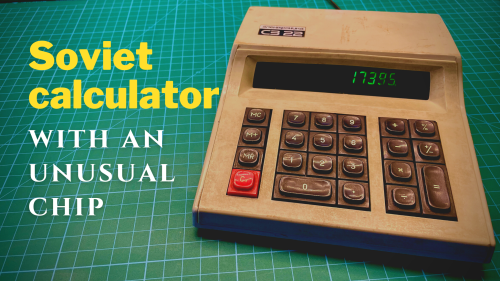In the category of retro equipment I usually throw in descriptions of calculators, because they are the biggest part of my collection. However, it’s time to introduce a little more variety, which is why a description of a vintage display appeared some time ago, while today I’d like to introduce you to an electronic clock that is more than 30 years old, manufactured in one of the factories of the former Soviet Union.
Also see:
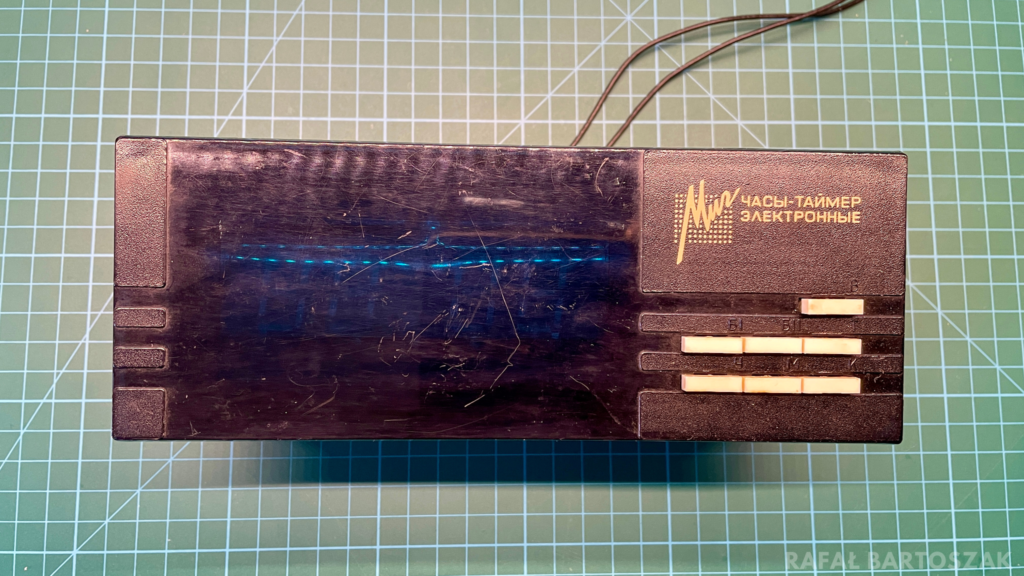
The protagonist of today’s material will be an electronic MIG clock (Электронные часы/таймер МИГ). The heyday of this type of design was in the 1980s and 1990s, when they adorned the shelves of many a home, in the countries of the former Eastern Bloc. The form of the clock is quite simple, ot a small cuboid made of black plastic, which crackles quite a bit at every touch. However, this is a standard feature of plastic coming from the USSR. The most interesting thing is, of course, the front panel of the device. It features the model designation along with the logo, as well as several white buttons. The largest part of the front panel is occupied by semi-transparent plastic, under which the time display is hidden. Despite its simple form, the case has a rather interesting feature. On its sides were placed metal clips that allowed the clock to be placed in a dedicated hole for it. In other words, it could have been part of a furniture cabinet that was popular in its time. This is an interesting and practical solution that officials of the central planning bureau probably came up with. It is worth knowing that the MIG clock was also available in a classic case, so it could easily be placed on a shelf.
Let’s pause for a moment at the very name of this device – MIG. What some people may have associated this abbreviation with the identical designation by which aircraft known since World War II are called. We can ask the question, was the clock named after an airplane? Well this thesis I can’t deny, but I can’t confirm it either, although in my opinion it is highly likely, since Russians like to name things after other things. By way of trivia, I can only mention that in the Soviet Union, in addition to MIG aircraft and clocks, there were also multi-turn pressure gauges designated by this acronym.
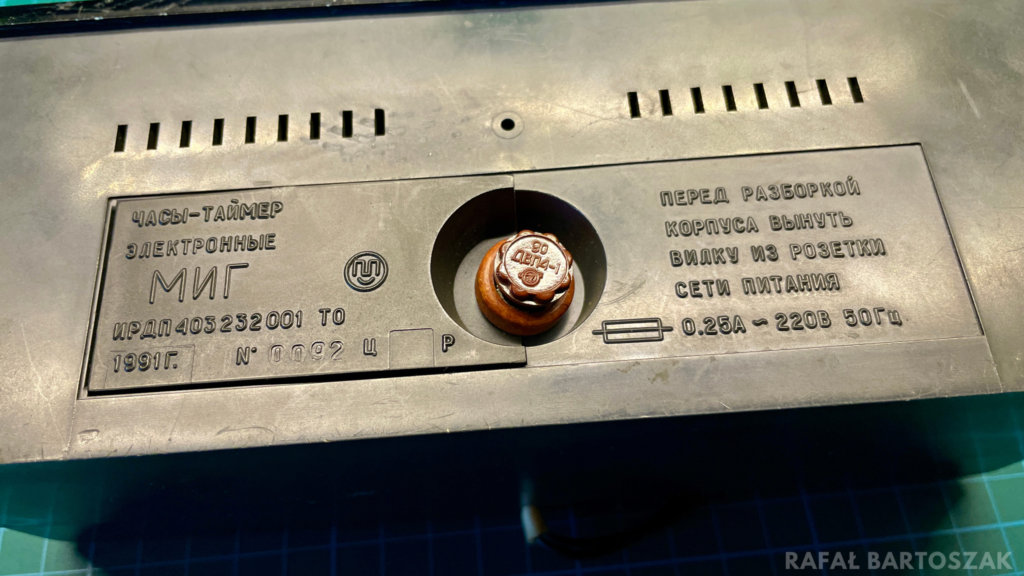
On the rear panel of the case we can find small ventilation holes, a fuse socket, the model designation, serial number, information about the production date and a message to disconnect the power supply before opening the case.
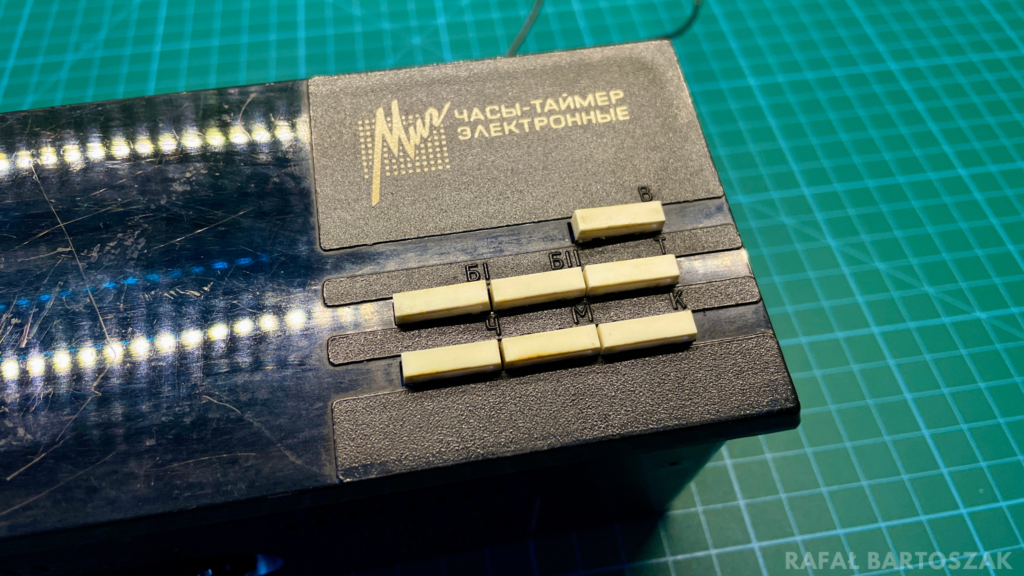
As I already mentioned, on the front panel you will find several buttons that control the operation of the clock. These are exactly:
- “В” – indication of the current time,
- “БI” – first timer,
- “БII” – second timer,
- “Т” – starting the timer,
- “Ч” – changing the digit of hours, in timer minutes mode,
- “М” – change of minutes digit, in seconds timer mode,
- “К” – correction of time.
After the description of the buttons of the MIG clock, you may notice that it can act as a programmable timer. In “ordinary” mode, the device indicates the current time, which can be adjusted, of course, but when the first or second timer is selected, it can count down the time, after which an audible signal will be triggered. The programmable timer can be set to a maximum of 59 minutes and 59 seconds.
The inside of a Soviet clock

Wanting to get inside the device, you need to unscrew three screws at the top of the case, then the plastic body can be disassembled into two parts. The upper one serves only as a protective form, while the lower one houses all the clock logic.
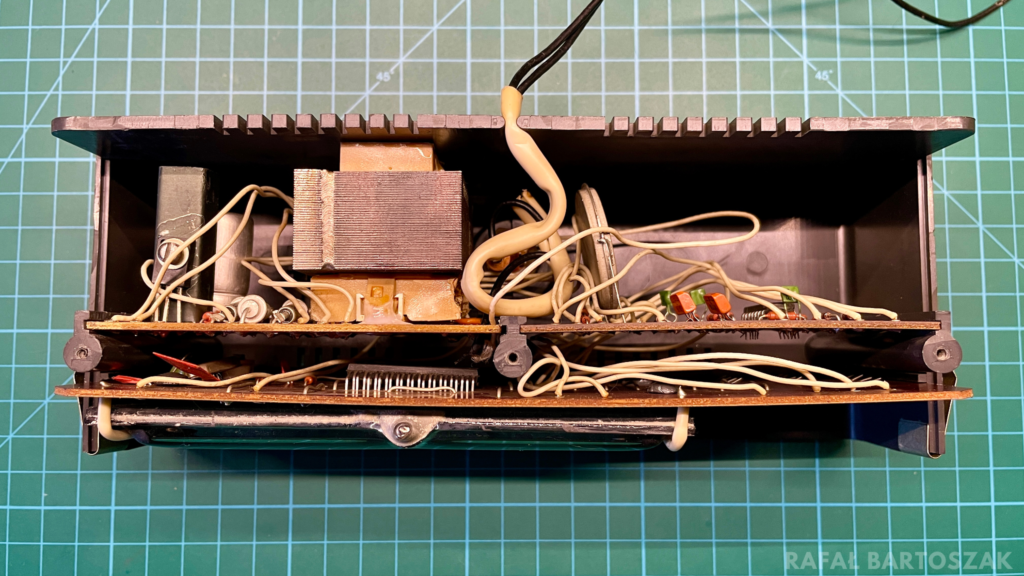
The MIG clock actually consists of three separate printed circuit boards. The largest board houses the display along with the control circuit, while the two smaller laminates, placed deeper, contain the power supply and the circuit that generates the sound along with the piezoelectric buzzer.
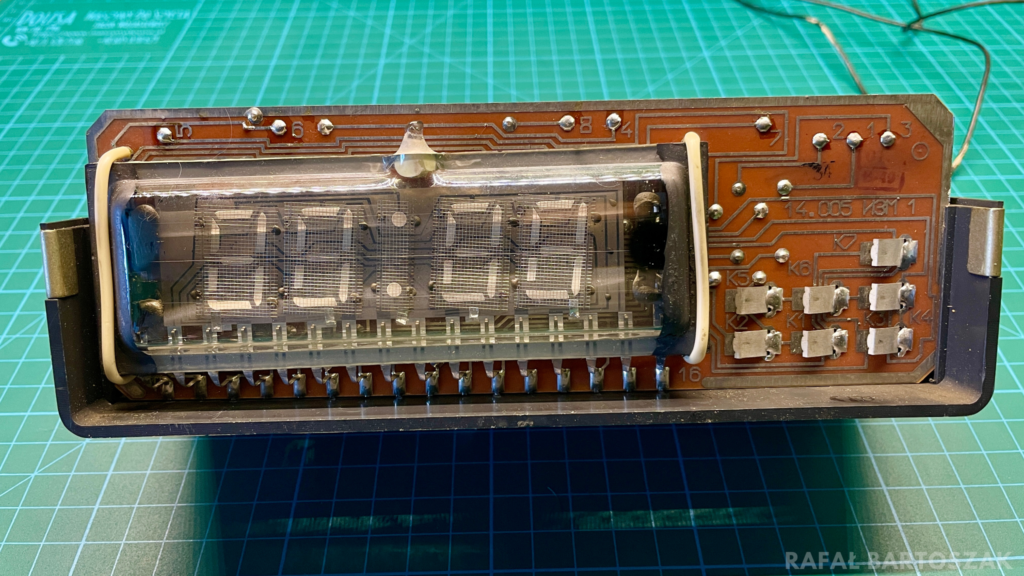
Let’s start with the main clock circuit. On its front there is a display, which is a VFD lamp marked ИВЛ1-7/5, dedicated to indicating the time. Besides, blocks of seven-segment digits are separated by two dots, which blink when the clock shows the time or counts down in timer mode. Besides, on the PCB you will also find seven buttons, having the form of small metal plates, which when pressed short-circuit an electrical circuit. We must admit that the mounting of the display itself looks quite funny, it is held on the edges by two sections of white wire.
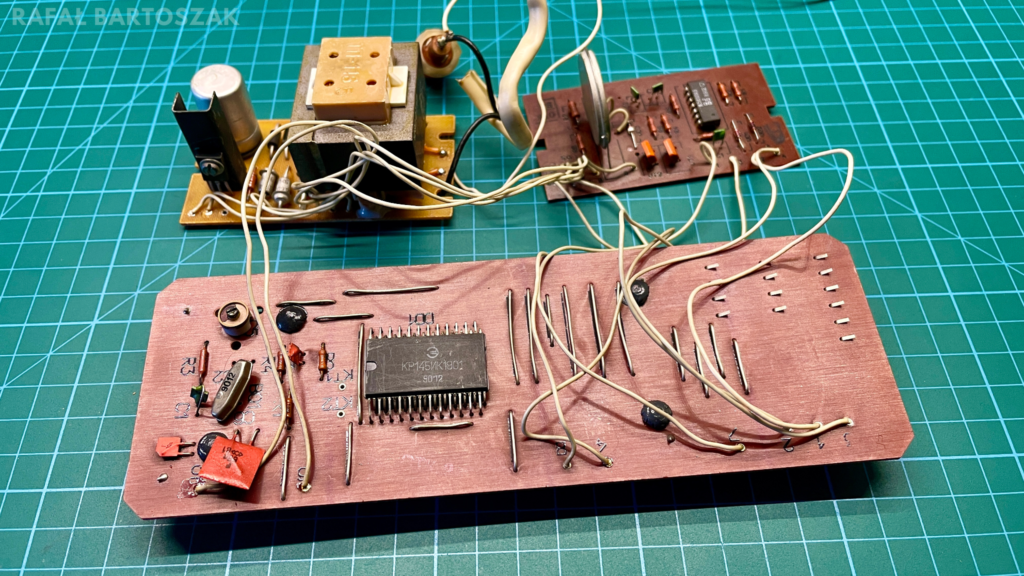
On the other side of the main circuit you will find the brain of the clock, which is the КР145ИК1901 chip, along with a resonator circuit located next to it based on a classic clock quartz with a frequency of 32.768 kHz.
After all, it's just a clock
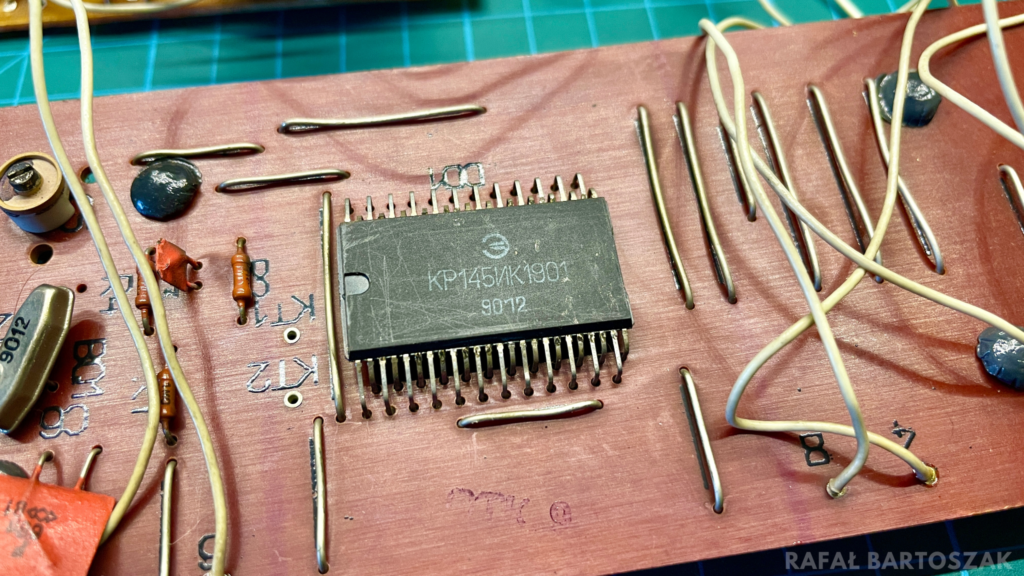
As I already mentioned, the main MIG timer chip is a chip with the designation КР145ИК1901, this particular chip was produced in the 12th week of 1990, you can find this out from the small marking on the case – 9012 – the first two digits indicate the year, the next ones the week of production. The chip itself physically is quite large, but that’s not surprising, since it’s not just a simple timer chip.
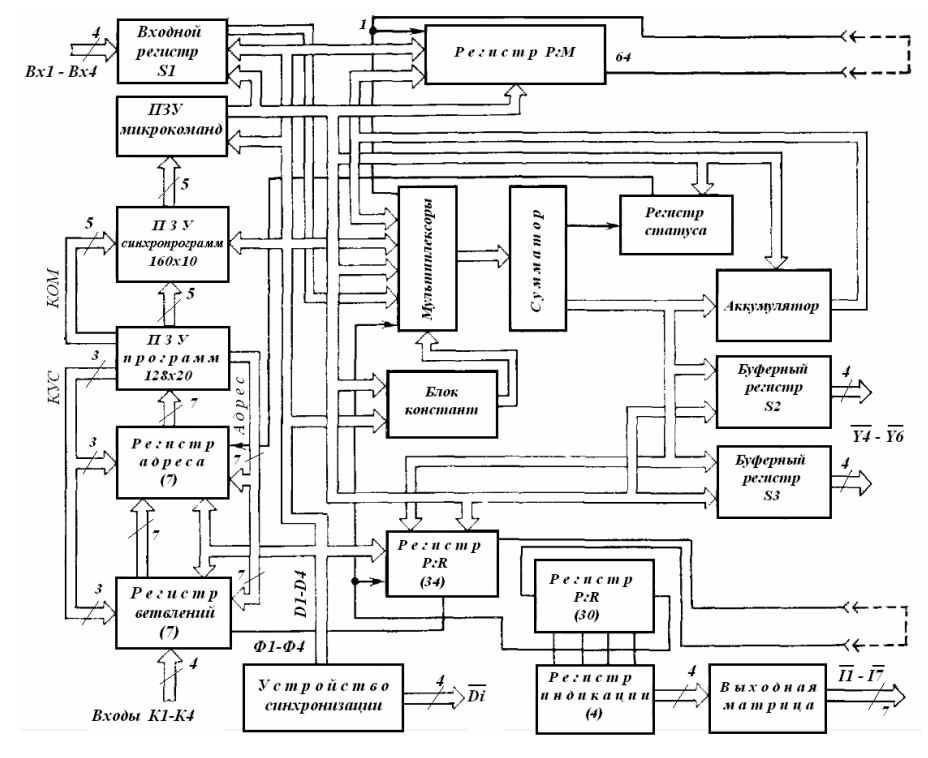
In fact, КР145ИК1901 is a fully functional microcontroller, designed precisely for clocks, alarm clocks and other small household appliances. The chip belongs to the КР145ИК19 family of microcontrollers, which implement the program written at the production stage.
The chip has a four-bit input data bus (Bx1 – Bx4), to which the buttons are connected, three of them are connected under the same input, but I will talk about the specifics of the MIG clock later, now let’s deal with the microcontroller itself. The circuit has a rather peculiar design, in fact, we can say that everything is connected to everything, through separate buses. In the central part we can find a simple ALU built here from a multiplexer, an address chip, an adder and an accumulator. On the left side, under the input data register S1, we found memories storing the main program and the synchronization program, they have a structure of 128x20b and 160x10b, respectively. In the lower part of the block diagram we can find the blocks that control the operation of the whole structure. On the right side there are two output registers S2 and S3, as well as an output array located in the lower right corner, generating signals for the seven-segment displays. The block visible at the very top labeled PM remains a mystery to me. Presumably, this is some kind of synchronization or data storage block needed for time synchronization, since an external clock signal is applied to it.
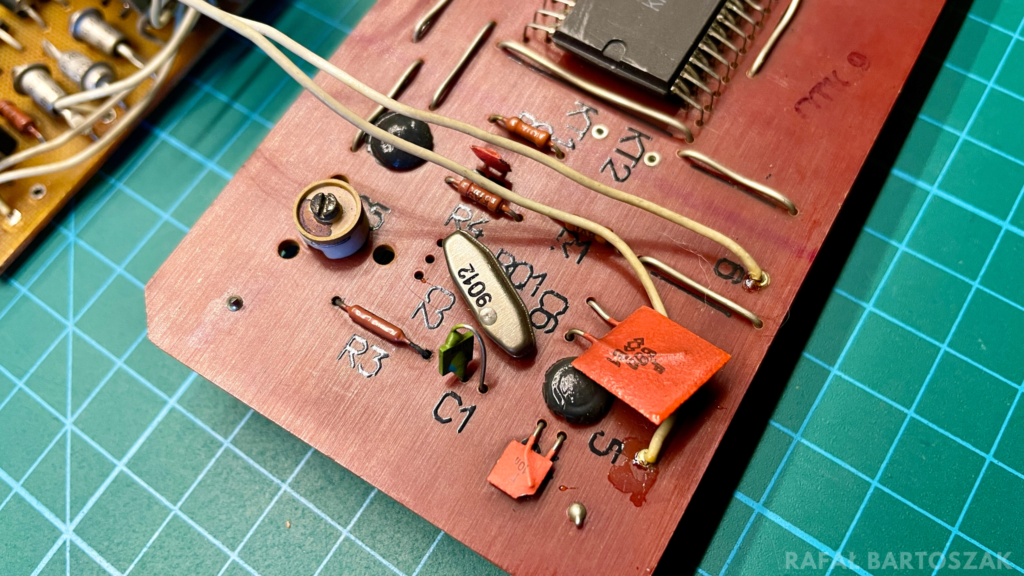
Right next to the main processor, we can find a simple generator circuit, based on a clock quartz resonator with a frequency of 32.768 kHz and a few passive elements such as resistors and capacitors. Noteworthy here is the trimmer, which allows you to adjust the generated frequency to a small extent, so that a second on the clock corresponds to a second in reality. The quartz resonator is usually the first component to fall in this type of Soviet clocks, so if the device does not work, it is worthwhile to take interest in this component first.
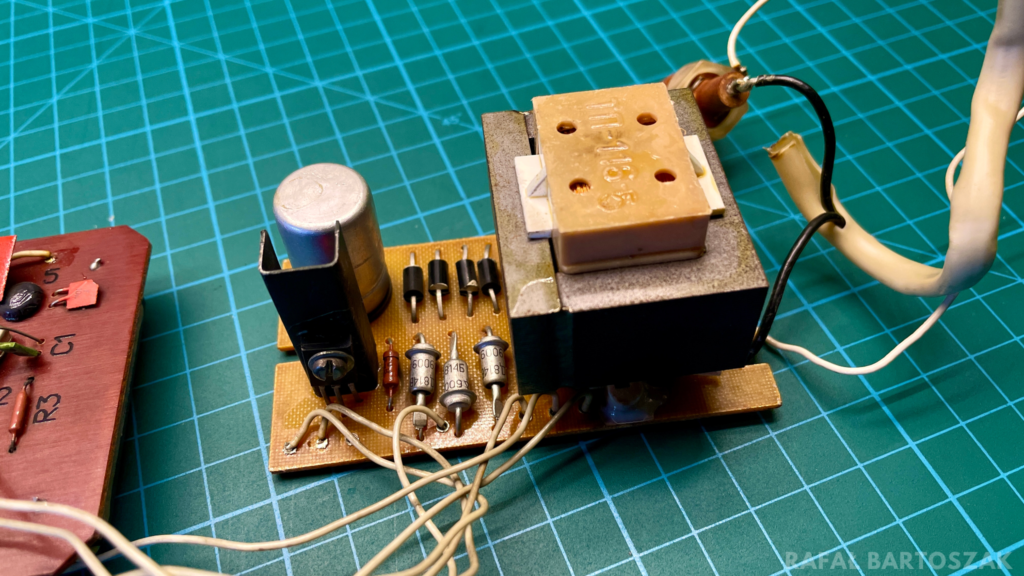
The clock power section is a fairly simple design generating a constant voltage of 27V and a 2.5V AC signal for the VFD lamp glow. Here we have a voltage-decreasing transformer, a rectifying bridge on four semiconductor diodes, a rather sizable voltage-smoothing capacitor and a stabilizer based on a transistor and three zener diodes.
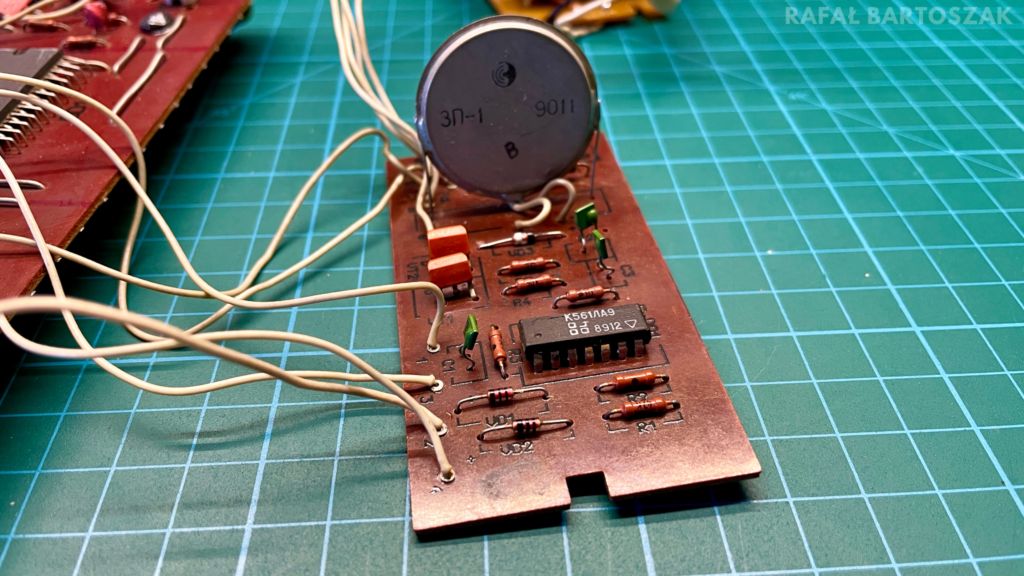
The last component we need to discuss is a board with a rather mysterious circular element. This is a piezoelectric buzzer that indicates the end of the countdown when the timer is in timer mode. The К561ЛА9 chip and its associated components are responsible for generating the sound. The chip has three, three-input NAND gates inside it and is equivalent to the Western CD4023. In addition, there are several passive components and two transistors on the board, but I will tell more about the operation of this circuit later.
How does the MIG timer work?
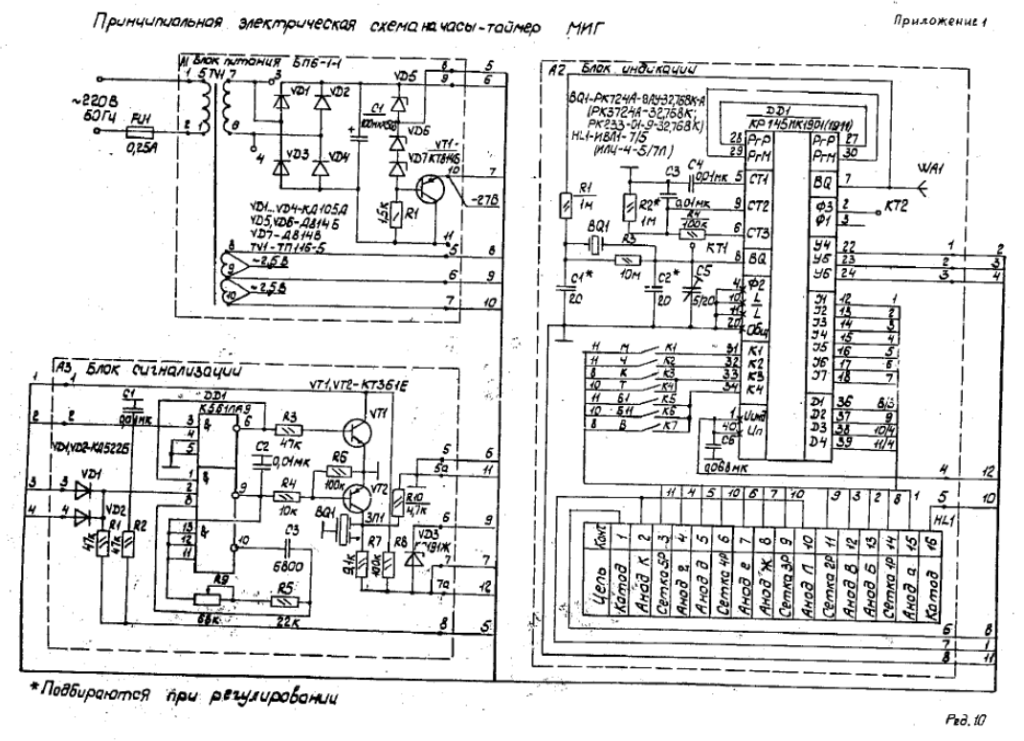
We have already learned all the components and circuits of the MIG timer, so we can try to pin everything together. The device is powered by mains voltage, which is later converted to a constant 27V and a variable 2.5V used to power the VFD lamp filaments.
The brain of the whole structure is the microcontroller КР145ИК1901, but we can call the heart the quartz generator composed of elements around the processor. It is this structure that generates the timing signal that drives the whole device. Buttons are connected to the inputs of the microcontroller, with three of them using the same input. How then are they differentiated? The principle is simple – the circuit is based on input and output at the same time. The signals short-circuited by the buttons are actually output signals of the processor, thanks to the input/output relationship it is possible to determine which button was pressed. The processor is also tasked with managing the VFD display. All digits are multiplexed, and they can be managed thanks to the output register signals mentioned a moment ago.
The sound generator circuit, whose executive element is a piezoelectric buzzer, is based on three NAND gates and transistors activated at appropriate times. By switching them on and off alternately, it is possible to produce a sound with modulated frequency.

Despite its years, the clock still works, although at first it did not. I bought it as damaged, but the defect was minor and easy to repair – one of the transformer leads was broken off. There were also traces that someone had once tried to repair it ineptly, melting the plastic cover near the core, but despite this, the connection was able to be rebuilt, thus bringing the device back to life. Interestingly, despite the years, the clock is still accurate, which means that the quartz resonator is still in good shape and can remain in place.
The MIG clock is a rather classic design for its years, but on the other hand it is interesting by a unique type of housing that allows the device to be mounted in a built-in. Besides, even though it’s just a clock, it’s equipped with quite an interesting integrated circuit which is actually a microcontroller with a unique architecture and operation.
Also see:
Sources:
- https://priborazbor.ru/elektronnye-chasy-tajmer-mig/
- https://www.diagram.com.ua/list/home/home590.shtml
- https://m.radiokot.ru/forum/viewtopic.php?p=3316362
- https://radio-hobby.org/uploads/datasheets/ivl/ivl1%207.5.pdf
- http://tec.org.ru/_bd/4/455_1451901.pdf
- https://m.radiokot.ru/forum/download/file.php?id=291487&sid=6b0c30a339da1a0317616cf7e4231cb4


